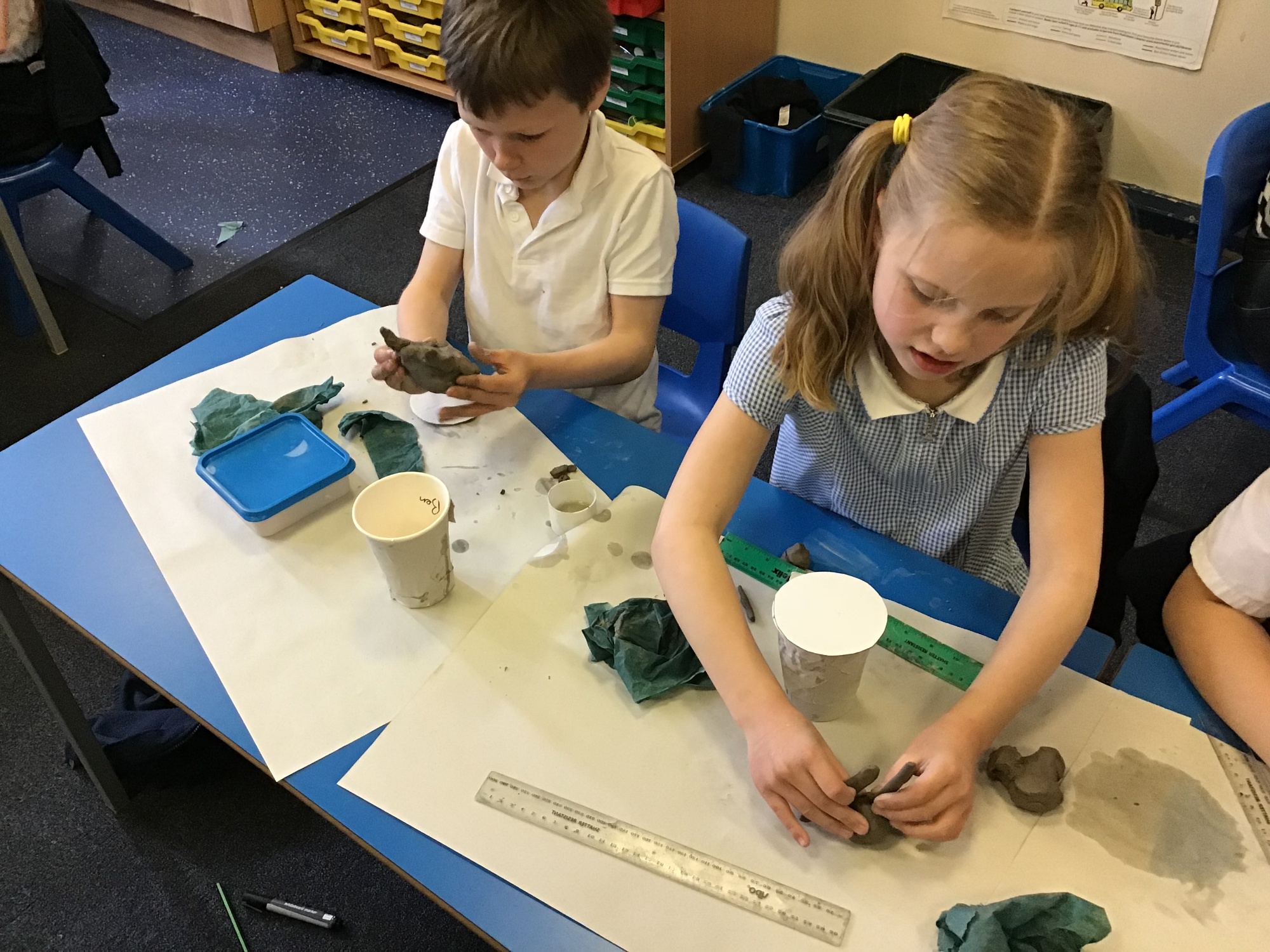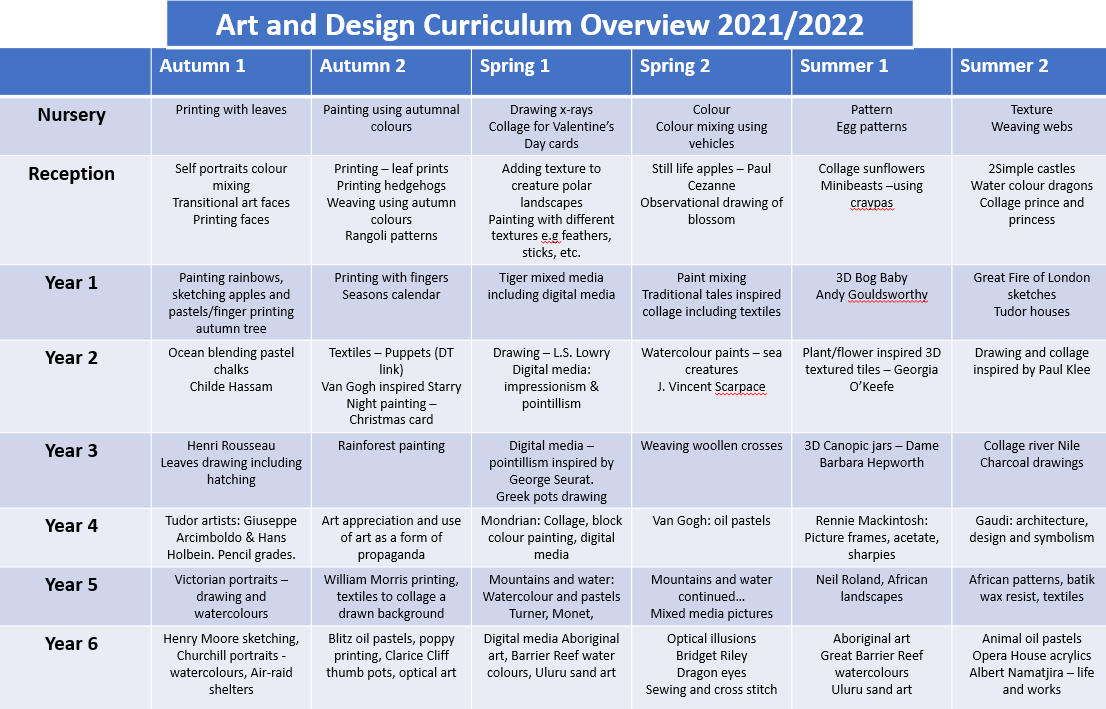Art and Design
Art and Design Intent Statement
Introductory statement
“Every child, young person and the protected characteristics has the opportunity to experience the richness of the arts, museums and libraries.”
Goal 5 of Arts Council England’s 10-year strategic framework Great Art and Culture for Everyone, 2015.
At Didsbury CE, it is our intent to provide a high-quality art and design curriculum that is designed to engage, inspire and challenge pupils, equipping them with the knowledge and skills to experiment, invent and create their own works of art, craft and design. During their time at DCE, we believe that children should be able to think critically and develop a more rigorous understanding of art and design. They should also know how art and design both reflect and shape our history, and contribute to the culture, creativity and wealth of our nation. Consequently, the children will have the opportunity to become increasingly proficient and confident at:
- producing creative work, exploring their ideas and recording their experiences
- drawing, painting, sculpture and other art, craft and design techniques
- evaluating and analysing creative works using the language of art, craft and design
- identifying great artists, craft makers and designers, and understand the historical and cultural development of their art forms.
Addressing social disadvantage (A curriculum for life for all)
Research by The Arts Council in 2016 found:
- Parents from higher socio-economic groups are significantly more likely to take their children to arts events and to encourage them to participate in the arts
- Research suggests parents who define themselves as Black and minority ethnic and from “other” backgrounds are less likely to take their children to arts events or encourage participation.
- Disparities between disabled and non-disabled children and young people seem to be driven largely by in-school rather than out-of-school factors.
Many children at Didsbury CE have the opportunity to experience art and design at home through cultural day trips in the UK or abroad, may have artwork in the home or have been encouraged to develop artistic skills by their parents, however, we are aware that this may not be the case for all of our pupils. Therefore, our curriculum has been designed to ensure social disadvantages, ethnicity or disability does not impact a child’s ability to engage and enjoy their art and design education. The ways in which we are addressing disadvantage amongst our pupils are:
- Teaching weekly art and design lessons to all pupils..
- Each half term children learn about a significant artist, craftsperson or designer from a range of ethnic backgrounds, genders, nationalities and time periods.
- Strong connections with community-based art projects such as The Didsbury Parsonage Trust and Didsbury Festival.
- Adapting resources or tools to meet the needs of children with SEND.
- Enrichment trips to galleries and museums are subsidised by Pupil Premium funding for those eligible.
Curriculum end points
The impact of this art and design curriculum is that children will critique their own and other’s artwork by asking open and closed questions. They will become reflective of their own work and discuss how to improve their artwork next time. Children will understand that art is made by a variety of people in a variety of ways. They will know that they are all artists. Each Key Stage Phase (Year 1 & 2, Year 3 &4 and Year 5 & 6) is given a set of skills that they need to have covered by the end of their phase. Some skills are taught exclusively to one year in the phase and others are revisited at a deeper level. The skills taught are influenced by Lancashire Grid for Learning’s Progression in Art and Design Skills guidance.
Children are assessed against the skills taken from Lancashire Grid for Learning and the National Curriculum before being recorded on the school’s assessment tracker. Children in Key Stage 1 and 2 complete a termly evaluation where they self and peer evaluate their work. They then answer questions about their artwork such as which skill was the most challenging, how would they improve their work next time etc. Final pieces of artwork are kept at school along with the evaluations as evidence. In EYFS, children’s art skills are assessed in line with Development Matters broad phases of development and Early Learning Goals (soon to be replaced by Development Matters 2021). This is recorded on Tapestry and in the school’s data tracking system. The children’s learning journey in art and design is reported formally to parents at the end of each academic year. The progress of each child will be tracked throughout their time at Didsbury CE Primary.
Curriculum planning and sequencing

We teach Art and Design within a knowledge-engaged curriculum, as a discreet unit with links to mainly the Design Technology, Computing, History or Geography curriculum. This provides an opportunity for the children to explore and develop ideas from first hand observations, learn of significant artists, designers or sculptors in history both from Britain and the wider world. As aforementioned, each Key Stage Phase have set of skills that they need to cover by the end of their phase. Some skills are taught exclusively to one year in the phase and for others we employ a spiral curriculum where skills are revisited at a deeper level in subsequent years. The skills taught are influenced by Lancashire Grid for Learning’s Progression in Art and Design Skills guidance.
Early Years
In EYFS, the children are exposed to a wide range of art and design techniques through the continuous provision learning environment. Children manipulate materials in the malleable and creative areas to create models of natural and man-made objects. They are taught how to cut, hold a paintbrush, blend colours and join materials. Children also learn of a famous artist and create artwork in their style.
Key stage 1 and 2
Art and Design is taught through weekly discreet lessons. In Key Stage One and Two, art lessons are often linked to the class topic in History or Geography. Art and Design techniques which relate to an artist, designer, craftsperson, particular historical period or culture are taught over a series of lessons. Different skills are taught during these lessons, be it sketching, creating different effects with paint or manipulating materials such as clay.
In Year 1, the children will develop their artwork independently in the learning areas, whereas in Year 2 and Key Stage 2 at the end of each unit, the children are encouraged to use a medium and technique of their choice to create an individual piece of art inspired by what they have been studying.
Reflecting the local context
Many art and design units we teach at Didsbury focus on the local area. In Year 5, the children learn about the different Victorian era architecture we have in the streets and roads close to the school. The children then sketch a Victorian street and include these period features in the houses. After, they finish the homes by painting with watercolour. They also learn about a local photographer, Neil Roland, and complete photography pieces in his style by photographing natural and man-made features in Didsbury before organising them by complementary colours using ICT. We also participate in annual community art projects such as Didsbury Festival and The Didsbury Parsonage Trust’s local art exhibition. Each year, Didsbury Festival set a theme and each participating school create banners, bunting, props or clothing to match this theme. Children are invited to create all elements for the procession during lunchtime art clubs.
The Didsbury Parsonage Trust invite local schools, Didsbury CE being one of these schools, to exhibit artwork in the parsonage building. Different year groups are selected for this each time. The children’s paintings, sketches or collages are mounted, framed and hung on the walls of the parsonage and 3D art, textiles or sculptures are displayed in cabinets. The exhibition is a popular event where families and the wider community come to celebrate the artistic achievements of the children in the local area. It is also in invaluable experience for the children involved as it confirms that they are artists.
A broad and balanced curriculum
Often, Art and Design links either to a Design Technology, Computing, History or Geography unit. This provides an opportunity for the children to explore and develop ideas from first hand observations, learn of significant artists, designers or sculptors in history both from Britain and the wider world.
For example, in Year 3 during their Egypt history topic, children learn about canopic jars and recreate them for 3D art. To support their understanding of sculpture, they study the sculptor Dame Barbara Hepworth. Children in all year groups learn how to use computer programs to develop digital media artwork, for example in Year 1 the children learn about the book The Tiger Who Came To Tea and create tigers using 2Simple. In Year 6, children create portraits of notable people from World War II and textile skills are developed in Years 1, 2, 3 and 5 when creating design and technology projects.
High academic ambition
Art and Design is a key part of our timetable and we pride ourselves on the high quality work the children produce. Their work is celebrated and appreciated by the whole school through regularly updated class and whole school display boards. The design of the curriculum ensures the sequence of Art and Design lessons imparts and builds upon artistic knowledge and skills: it is not just about completing the end piece. We believe all children are artists and encourage all children to believe this too, regardless of their backgrounds. To achieve this, we provide weekly opportunities in school for artistic development along with regular enrichment through community projects. Pupil Premium is well used to ensure those entitled to funding are able to attend art trips or resources. Similarly, for children with SEND, activities are carefully planned and adapted to the individual needs of the child and appropriate resources or modifications made to ensure they are able to access the learning. Our art and design curriculum enables all children to be artists, allows children to experience art and design in local or wider contexts and challenges children to fulfil their potential.


